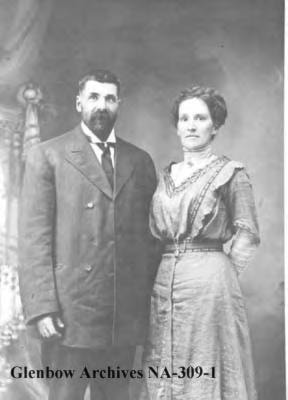Edward William Barnett was born in Almonte, Ontario in 1858.
At 19, he would make his way by rail, riverboat and foot to the Sierra Nevada mountains. After making his way back north, and arriving in Winnipeg sometime after, he met up with three members of the Royal North West Mounted Police, and traveled back with them to their station at Fort Walsh, becoming a member of the police force in August of 1878.
During his time, he was noted as being part of the ‘escort group’ that moved Chief Sitting Bull and his party to the Canada-U.S. border.
The group had moved down along the Calgary & Edmonton trail.
After being discharged in 1881, he was part of the group that built what is considered the first permanent place of business in Central Alberta near the old Red Deer River crossing.
Afterwards he was given his Government of Canada land grant for his time in the RNWMP. This was the practice at the time, and although the practice of awarding officers in the Mounted Police land after three years of ‘satisfactory’ service ended roughly a year after Edward had joined, he still made the cut.
Mr. Barnett took his land grant and made his way north.
He would then settle in an area along the C&E trail. He staked a claim under the Dominion Lands Act of 160 acres, and using his land grant from the RNWMP, he chose a similar sized parcel.
Right beside it Edward’s brother would join him on his new homestead and the two of them would build a stopping house originally known as Barnett’s Rest.
They would also establish a ranch. When the C&E Railway (eventually C.P.) arrived on the site in 1891, there was 19 adults, and almost as many children. Many of whom were from Almonte area. The area would then become known as Barnett’s Siding.
In 1893 the president of the Canadian Pacific Railway would rename Barnett’s Siding after Father Lacombe, the famous missionary who worked with many of the local indigenous population, and worked to keep many of them from joining the 1885 Rebellion.
Edward Barnett would commission the first land survey of his property, allowing him to subdivide it and sell the lots. If you venture to Lacombe, have a wander down Barnett (50th) Ave. where his homestead and Land Grant property stood.
The sprawling property would also run north between 53rd and 45th Streets, and with partnership assistance from Augustus Meredith Nanton and John Henry Munson, Barnett would divide up his other 160-acre parcel, developing much of it into early residential lots.
He would then retain roughly 50 percent of whatever was made from the venture. The group would later work to develop the area with Dominion Land agent Jacob Doupe.
Edward would also marry Lacombe’s first teacher Miss Elvie Green, who a cairn along Hwy. 12 was erected in honour of.
Lacombe became a town in May of 1902.
Barnett, who had never liked being in crowded places, and although was an outgoing person known for helping new settlers get started on their homesteads, was considered a loner.
So as Lacombe grew, Barnett wanted more space.
He would sell his shares in his Lacombe holdings and move his family to the Lamerton area in the early 1900s.
However the Lamerton area quickly started developing as well, and so the Barnetts then moved east of Botha. Despite the fact the area they lived in was spacious enough for Edward’s liking, he and his wife wanted their children to receive a good education.
So they moved a little closer to the growing community of Stettler, and their children would attend Liberal School. The Barnett home would be roughly half a mile north of Liberal church, and both Elvie and Edward would sit on the boards of both the school and the church.
The former Mounty-turned-homesteader-turned-community builder would spend 33 years in the Stettler area, until his passing in August of 1939.
In addition to funeral services performed by Rev. T.R. Davies, the local Masonic Lodge organized the graveside services, which was done by the Stettler Canadian Legion branch.
The Legion performed a small service, and then sounded last post for the former Mounted Police officer. Pallbearers at the pioneer’s funeral included Messers Colley and McIvor.
Elvie would run the Liberal area ranch for about 10 years before selling and moving to Kelowna.
She would pass away in 1963. Both her and her husband are buried at the Liberal Cemetery.
